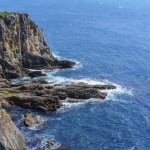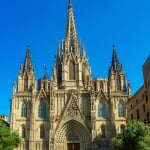Name: Ishizuchi Mountain
Address: Wakayama, Kōya, Kamakura, Kamigun, Uwa, Ehime
Official Website: https://ishizuchisankei.com/spot/spot01/
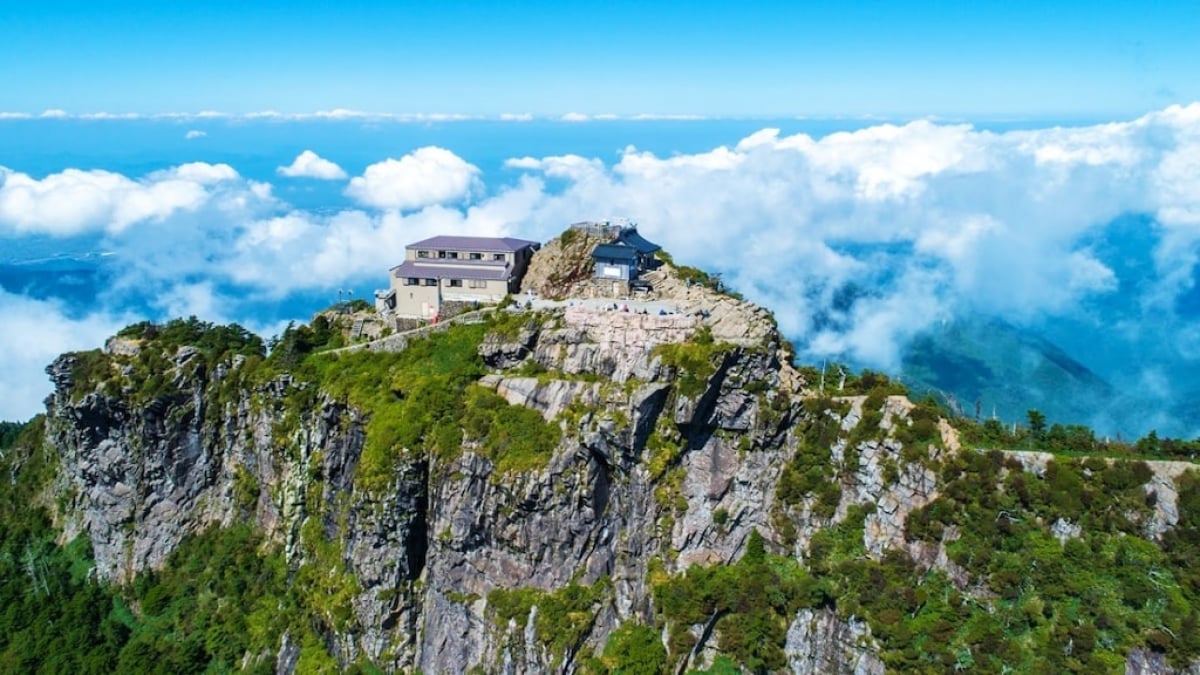
33 Recommended Power Spots Created by the Majestic Sea and Nature of Ehime!
The name "Ehime" comes from the word "Ehime", meaning "cute princess" or "beautiful goddess," found in Japan's oldest historical book, the "Kojiki." It is a place where the traditional streetcars run, and it has been the setting for modern literary works such as "Botchan" and "Clouds Above the Hill."
Ehime has unique regional characteristics divided into three areas: Nan'yo, Tōyo, and Chūyo. While Matsuyama, the most populous city in Shikoku, is located here, it is also surrounded by magnificent nature, which includes famous power spots such as shrines, temples, ruins, and mountains! Here, we introduce 33 places in Ehime, perfect for a girls' trip, where you can find sources of good fortune. It is said that Ehime is a land loved by the gods. Embrace the nature of Ehime, and wear the strong and wonderful aura of good fortune!
table of contents
[x] close
33 Recommended Power Spots Created by the Majestic Sea and Nature of Ehime!
- 1. The Tallest Mountain in Western Japan! A Blissful View from the Summit! "Ishizuchi Mountain"
- 2. A Mountain with Seasonal Festivals! "Ishizuchi Shrine" on the Tallest Mountain in Western Japan
- 3. A Scenic Spot Created by Rich Nature! "Nametoko Gorge"
- 4. Who Made It and Why? A Mysterious Spot "Shiraishi-no-Hana Giant Stones"
- 5. A Spot to Feel Nature! "Fukuchizou's Spring Water"
- 6. "Ryūkō-ji" Temple Founded by Kōbō Daishi
- 7. The Oldest Shrine on Hakata Island, Famous for Salt! "Kitauura Hachiman Okami Shrine"
- 8. A Spot to Catch a Glimpse of Ancient Culture "Tateishiyama Giant Stones (San Shū-en)"
- 9. Try Forest Bathing in the Natural Enclosure Surrounded by Forests! "Myoken Shrine"
- 10. A Shrine Founded by a Local Official from the Yamato Period "Kunitsuhiko-no-Mikoto Shrine"
- 11. Surrounded by Scenic Views, Embrace the Aura of Happiness! "Yokomine-ji Okunoin Hoshigamori"
- 12. A Place for the Citizens of Niihama! A Shrine for Safe Childbirth "Ichimonji Shrine"
- 13. A Shrine Said to Grant Blessings Even with One-Handed Prayers "Katadeyakushi (Koushakuji Temple)"
- 14. A Shrine for the Tanuki Near Matsuyama Castle! "Yatsumata Enoki Osode Daimyojin"
- 15. A Natural Air Conditioner! Touch the Mysteries of Nature "Saragamine Wind Cave"
- 16. A Unique Scenic Spot Loved by Local Contemporary Artist! "Nozoki-Iwa"
- 17. Enjoy the Plum Blossoms and the Heike Legend! "Seijouji Temple"
- 18. The Legend of Sugawara Michizane, the God of Learning, Still Lives On at "Tsunashiki Tenmangu Shrine"
- 19. A Nature-Rich 100 Famous Mountain Spanning Kochi and Ehime! "Kanpūzan"
- 20. A Branch Shrine of the Izumo Taisha Shrine in Shimane! "Izumo Taisha Matsuyama Branch"
- 21. In Spring, the Back of the Shrine Turns into a Cherry Blossom Mountain! "Kumano Shrine" in Saijō City
- 22. Get Rid of Bad Luck and Pray for a Safe Year! "Yakuyoke Daishi, Henjouin Temple"
- 23. A Mysterious Spot that is the Sacred Object of the Shrine! "Tenchū-seki (Goto-seki)"
- 24. An Artistic Scenic Spot Created by Nature's Mysteries "Namerakawa Gorge Torii Iwa"
- 25. A Pilgrimage Site with 1300 Years of History! "Jōruri-ji Temple"
- 26. Autumn Brings a Power-Filled Festival! A Shrine with Dignity and Tradition "Iso-no-Jingu Shrine"
- 27. The Chief Deity Who Oversees All of Japan's Mountains! "Shingū Shrine" in Matsuyama
- 28. Isang Lugar ng Paglalakbay na May 1300 Taong Kasaysayan! "Jōruri-ji Temple"
- 29. Ang Taglagas Ay Nagdadala ng Isang Puno ng Enerhiya na Pista! Isang Dambana ng Tradisyon at Dignidad "Iso-no-Jingu Shrine"
- 30. Ang Pangunahing Diyos na Nangangasiwa ng Lahat ng Bundok ng Japan! "Shingū Shrine" sa Matsuyama
- 31. A Must-See Historical Spot Representing Matsuyama, Ehime! "Matsuyama Castle"
- 32. A Temple with Many Power Spots for Pilgrims "Ishite-ji Temple"
- 33. A Shrine Devoted to the God Who Governs the Mountains, Highly Revered by the Imperial Family "Ōyamatsumi Shrine"
- ◎ Summary
1. The Tallest Mountain in Western Japan! A Blissful View from the Summit! "Ishizuchi Mountain"
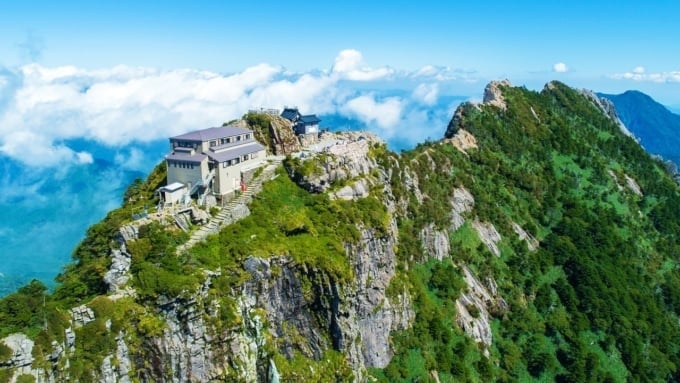
At an elevation of about 1,980 meters, this mountain, known as "Iyo's Takamine" (Takamine of Iyo), has been a center of mountain worship for centuries. It has been a training ground since the Nara period, and it is said that the famous monk Kukai also practiced here.
Ishizuchi Mountain is the highest in Western Japan. From the summit, you can enjoy a breathtaking view of Tosa Bay, the Seto Inland Sea, and depending on the weather, even the mountains of Chugoku and Kyushu! This mountain is one of Japan's 100 Famous Mountains, 100 Scenic Views, and Seven Sacred Mountains, making it a well-known and iconic peak.
2. A Mountain with Seasonal Festivals! "Ishizuchi Shrine" on the Tallest Mountain in Western Japan
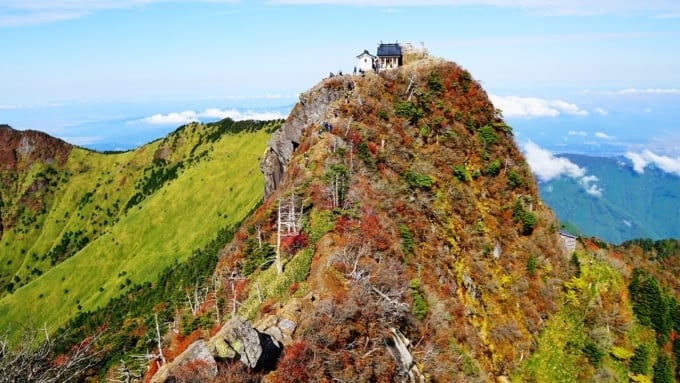
Ishizuchi Shrine, located in Saijō City, Ehime Prefecture, enshrines Ishizuchi Mountain, which stands at about 1,980 meters, the tallest mountain in Western Japan. The shrine consists of four sections: the summit shrine, Joju Shrine at the 7th station, the remote worship hall at the foot, and the main shrine near the train and national road. These are collectively known as the Ishizuchi Shrine.
Seasonal events are held throughout the year to show gratitude for nature's blessings and the protection of the gods.
Name: Ishizuchi Shrine, Sacred Peak Ishizuchi
Address: 797 Nishida, Saijō City, Ehime Prefecture
Official Website: http://ishizuchisan.jp/
3. A Scenic Spot Created by Rich Nature! "Nametoko Gorge"
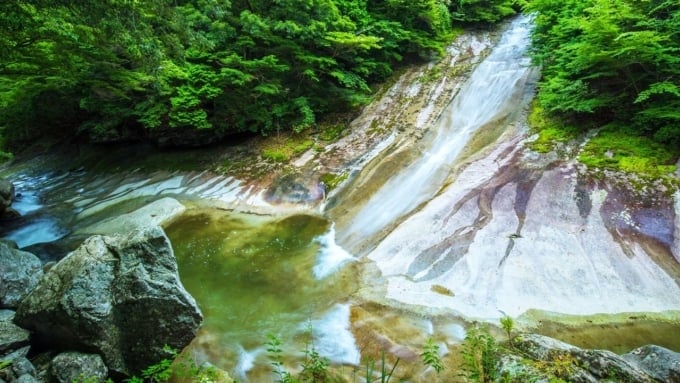
Nametoko Gorge is a nature-rich valley stretching from Uwajima City in Ehime to Matsuno Town in Kitauwa District. The valley is almost entirely composed of granite, which has formed smooth rock surfaces through years of erosion, giving rise to the name "Nametoko" (slippery rock).
The gorge has a 12-meter-long walking trail, and the waterfall "Yukiwara no Taki" (Snow Ring Falls) is also chosen as one of Japan’s 100 Famous Waterfalls. The best time to visit is during the autumn foliage season when the vibrant colors of the leaves, the flowing waterfalls, and the gorge create a beautiful natural scene.
Name: Nametoko Gorge
Address: Nogawa, Uwajima City, Ehime
Official Website: http://www.uwajima.org/course/index7.html
4. Who Made It and Why? A Mysterious Spot "Shiraishi-no-Hana Giant Stones"
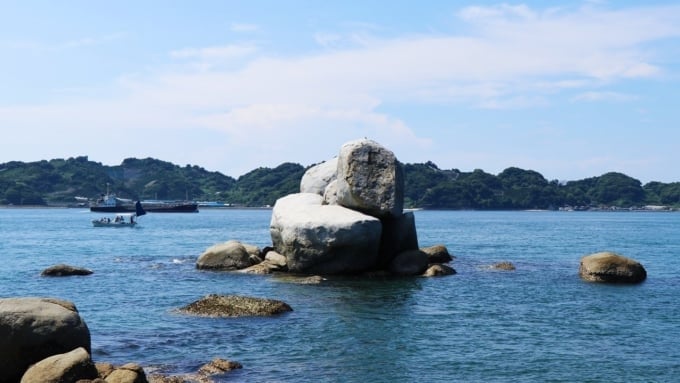
Located facing the Seto Inland Sea and Saian Bay, this group of massive granite stones floats above the sea surface in Matsuyama City, Ehime Prefecture. The origins of these stones remain shrouded in mystery, with several theories surrounding their formation. Some believe they were naturally stacked over time, while others suggest they were used as a solar observation device in ancient times.
Around the spring and autumn equinox, for a few days, the sun sets through the hollow part in the center of the stones, creating a mystical and breathtaking view.
Name: Shiraishi-no-Hana Giant Stones
Address: Katsuo Town, Matsuyama City, Ehime
5. A Spot to Feel Nature! "Fukuchizou's Spring Water"
Located in Kumakōgen Town in the central part of Ehime Prefecture, near Kōchi Prefecture, this soft water spring is known for its delicious, easy-to-drink water that is said to be ultra-soft and gentle on the body. It is also believed to bring blessings of health when visited along with prayers to Fukuchizou.
Many visitors, not just from the local area but from outside the prefecture, come to pray and drink the tasty spring water, making it a power spot where you can experience the kindness of nature! It is located by the roadside, so be careful not to miss it!
Name: Fukuchizou's Spring Water
Address: Yanagigawa, Kumakōgen Town, Kamigun, Ehime
Official Website: http://powerspot.crap.jp/s/6644.html
6. "Ryūkō-ji" Temple Founded by Kōbō Daishi
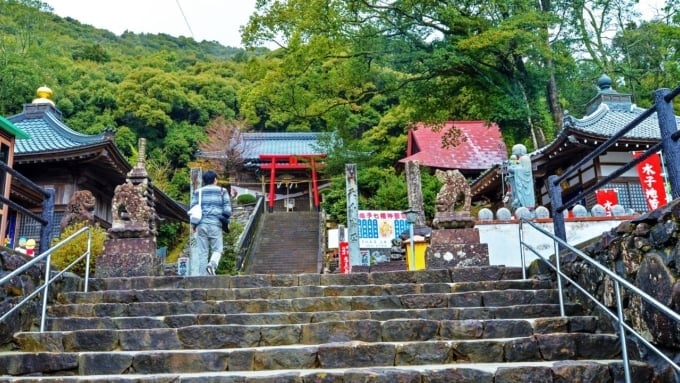
Known locally as the "Mika Inari of Sanmen," Ryūkō-ji is one of the 88 sacred temples of Shikoku, attracting many pilgrims year-round. The temple gate is made of stone and shaped like a torii, preserving the historical blend of Shinto and Buddhism. It was founded by Kōbō Daishi in the 9th century.
In recent years, the number of pilgrims has been increasing, and as you walk among the temples, you’ll surely be moved by the pilgrims who travel slowly, reflecting on their journey.
Name: Ryūkō-ji
Address: 173 Togari, Sanmen Town, Uwajima City, Ehime Prefecture
Official Website: http://www.88shikokuhenro.jp/ehime/41ryukoji/
7. The Oldest Shrine on Hakata Island, Famous for Salt! "Kitauura Hachiman Okami Shrine"
This shrine was founded at the end of the 7th century (673 or 674) by transferring the spirit from Hakosaki Shrine in the Hakata region of Fukuoka. It is said that the name of Hakata Island, "Hakada," is derived from this shrine.
Inside the shrine, a model of a traditional Japanese ship called "Hachimaru" is displayed, which is an important artifact of the naval culture. The theater, where plays can be performed, was built during the late Edo period. There is also a turtle-shaped stone, said to bring blessings for longevity and matchmaking.
Name: Kitauura Hachiman Okami Shrine
Address: 2463 Kitau, Hakata Town, Imabari City, Ehime Prefecture
Official Website: http://www.iyokannet.jp/front/spot/detail/place_id/4040/
8. A Spot to Catch a Glimpse of Ancient Culture "Tateishiyama Giant Stones (San Shū-en)"
On the summit of Tateishiyama, a mountain on Ikina Island in the Kamijima Islands of Ehime Prefecture, there are numerous giant stones. At the foot of the mountain, in San Shū-en, there is a massive stone called a "Menhir," which stands 7 meters tall. These stones are believed to have been used during festivals in the Yayoi period.
In addition, many stone tools from the Paleolithic and Yayoi periods have been excavated around the summit and nearby areas, making it a power spot where you can feel the ancient culture of Japan!
Name: Tateishiyama Giant Stones (San Shū-en)
Address: Ikina, Kamijima Town, Ochi District, Ehime Prefecture
Official Website: http://www.town.kamijima.lg.jp/site/kanko/
9. Try Forest Bathing in the Natural Enclosure Surrounded by Forests! "Myoken Shrine"
The forest surrounding the shrine consists of natural subtropical plants, with some trees believed to be several hundred years old. This area has been designated as a natural monument of Matsuyama City, and around 50 different species of plants, including camphor trees and camellias, thrive here.
The shrine was founded in the 9th century, in the year 836, by Emperor Nimmyō during the Heian period. In addition to visiting the shrine, it’s also recommended to enjoy forest bathing among the ancient trees and breathe in the fresh air. It is said to bring blessings to those who visit!
Name: Myoken Shrine
Address: Matsuyama City, Ehime Prefecture
Official Website: https://goo.gl/XVUruP
10. A Shrine Founded by a Local Official from the Yamato Period "Kunitsuhiko-no-Mikoto Shrine"
This shrine features a main gate that is designated as an important cultural property of the prefecture. It was founded by the Mononobe clan, who governed this area as local officials (Kuni-no-Miyatsuko) during the Yamato period. The shrine is believed to bring blessings for the safety and development of the region.
The most exciting event is the autumn festival. Known as the Kazahaya Fire Festival, this festival features a danjiri (a decorated cart) parading through the town, and a unique and wild tradition of throwing the mikoshi (portable shrine) from the river and the shrine’s stone steps!
Name: Kunitsuhiko-no-Mikoto Shrine
Address: 107 Hattanji, Matsuyama City, Ehime Prefecture
Official Website: https://goo.gl/hyZmoJ
11. Surrounded by Scenic Views, Embrace the Aura of Happiness! "Yokomine-ji Okunoin Hoshigamori"
Located in Saijō City, Ehime, this Shingon sect temple is the 60th temple in the Shikoku 88 Temple pilgrimage. It is also a place where Kōbō Daishi performed a ritual for protection at the age of 42. The temple is situated on the slopes of Ishizuchi Mountain, the tallest in Western Japan, and in May, the rhododendrons are in full bloom.
The temple is sometimes called the "Rhododendron Temple" because the grounds are covered in a delicate pink hue from the blooming flowers. Surrounded by these beautiful blossoms, you can take many wonderful photos!
Name: Yokomine-ji Okunoin Hoshigamori
Address: 2253 Ishizuchi, Komatsu Town, Saijō City, Ehime Prefecture
Official Website: http://iyokannet.jp/front/spot/detail/place_id/4538/
12. A Place for the Citizens of Niihama! A Shrine for Safe Childbirth "Ichimonji Shrine"
In ancient times, it was believed that when famine or disease spread, the emperor would pray to the gods to alleviate the disaster, and this prayer was called a "Chokugan" (imperial decree). Ichimonji Shrine was the chokugan shrine of Emperor Saga, the second son of Emperor Kanmu and the ancestor of the Taira clan. It is a shrine with deep devotion for safe childbirth.
During the Sengoku period, the shrine was once burned down during a battle, but after the Mōri clan rebuilt it, it was carefully maintained. The shrine’s peaceful atmosphere makes it a relaxing spot for the local citizens.
Name: Ichimonji Shrine
Address: 1-3-1 Ichimonji Town, Niihama City, Ehime Prefecture
Official Website: http://www.ikkujinja.or.jp/
13. A Shrine Said to Grant Blessings Even with One-Handed Prayers "Katadeyakushi (Koushakuji Temple)"
Katadeyakushi, officially named Koushakuji Temple, was founded by Kōbō Daishi. According to a local legend, when the temple was first established, a person who had a disability and could only use one hand prayed to Yakushi Nyorai (the Medicine Buddha) with that hand. Miraculously, the other hand was healed. This story led to the belief that one can receive blessings even by praying with one hand.
At the beginning of the year, people wishing for a year free of illness and injury can visit this temple to pray for health and safety.
Name: Katadeyakushi (Koushakuji Temple)
Address: 1504 Takubo, Tōon City, Ehime Prefecture
Official Website: http://katateyakushi.com/index.html
14. A Shrine for the Tanuki Near Matsuyama Castle! "Yatsumata Enoki Osode Daimyojin"
This small shrine is known as a "hokora" (a small shrine that enshrines gods). The legend behind Yatsumata Enoki Osode Daimyojin is a fascinating one, involving a tanuki with mystical powers that lived in a large enoki tree near Matsuyama Castle during the late Edo period.
Although the large enoki tree was cut down to make way for the streetcars, the tanuki's spirit was enshrined in a nearby temple, Rokakudō, and the shrine still stands today.
Name: Yatsumata Enoki Osode Daimyojin
Address: 4 Niban-cho, Matsuyama City, Ehime Prefecture
Official Website: http://powerspot.crap.jp/s/6016.html
15. A Natural Air Conditioner! Touch the Mysteries of Nature "Saragamine Wind Cave"

Located in the Chūyo region of Ehime Prefecture, Saragamine is a mountain that houses the Kenbai Forest Park, a designated natural park. Saragamine features a wind cave that, due to temperature differences and weather conditions, becomes shrouded in mist during the summer, creating a natural air conditioner.
Cool air flows from the cave year-round, making it a power spot that allows climbers to experience the wonders and grandeur of nature. Visit in the summer to enjoy the mountain's natural cooling effects!
Name: Saragamine Wind Cave (Kenbai Forest Park)
Address: 896-24 Kamibayashi Otsu, Tōon City, Ehime Prefecture
Official Website: http://iyokannet.jp/front/spot/detail/place_id/1497/
16. A Unique Scenic Spot Loved by Local Contemporary Artist! "Nozoki-Iwa"
Located in the Akamatsu district, which serves as the gateway to Uwajima Port, this mysterious scenic spot is also favored by Shinnosuke Otake, a contemporary artist from Uwajima. The rock is believed to have originated from volcanic lava caused by an eruption.
This spot has been selected as one of the "Uwajima New 24 Views," and its mysterious atmosphere makes it feel as though a giant creature is peering out over the sea. While not a living being, it recalls the image of "Nessie," the famous Loch Ness Monster from the UK.
Name: Nozoki-Iwa
Address: 2342 Oura, Uwajima City, Ehime Prefecture
Official Website: http://powerspot.crap.jp/s/4816.html
17. Enjoy the Plum Blossoms and the Heike Legend! "Seijouji Temple"
Seijouji Temple, a Soto Zen temple, was founded in the 8th century in 750 during the Nara period by Emperor Kōken as a chokuganji (an imperial temple founded to pray for the prosperity of the nation and the imperial family).
This temple is home to an ancient plum tree known as "Hachibō no Ume," which has been designated a natural monument of the town. Near the tree is the tomb of Tokihime, the fifth daughter of Taira no Kiyomori, and this place was also the setting for the Heike clan's fugitive legends. In March, the plum blossoms bloom beautifully.
Name: Seijouji Temple
Address: 913 Teramura, Uchiko Town, Kitagu District, Ehime Prefecture
Official Website: http://powerspot.crap.jp/s/4605.html
18. The Legend of Sugawara Michizane, the God of Learning, Still Lives On at "Tsunashiki Tenmangu Shrine"
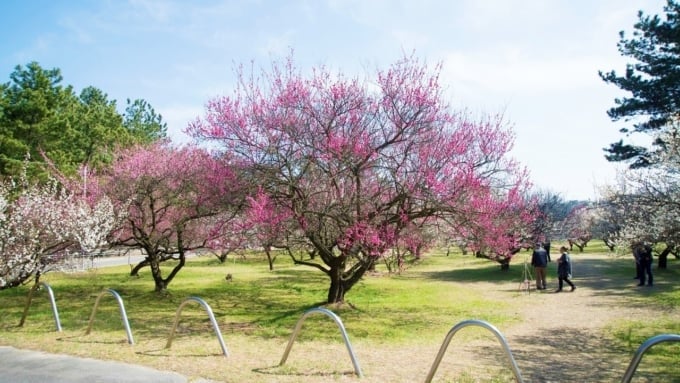
Located about 6 kilometers from the center of Imabari, this shrine is connected to the god of learning, Sugawara Michizane. It is a beautiful spot where approximately 120 plum trees, with about 30 different varieties, bloom.
In February, a plum festival is held here, and during this season, the shrine is crowded with visitors who come to pray for academic success while enjoying the plum blossoms. Before important exams, it's a great idea to visit and pray in front of the lovely plum blossoms!
Name: Tsunashiki Tenmangu Shrine
Address: 6-2-1 Sakurai, Imabari City, Ehime Prefecture
Official Website: http://mapio.net/o/4329413/
19. A Nature-Rich 100 Famous Mountain Spanning Kochi and Ehime! "Kanpūzan"
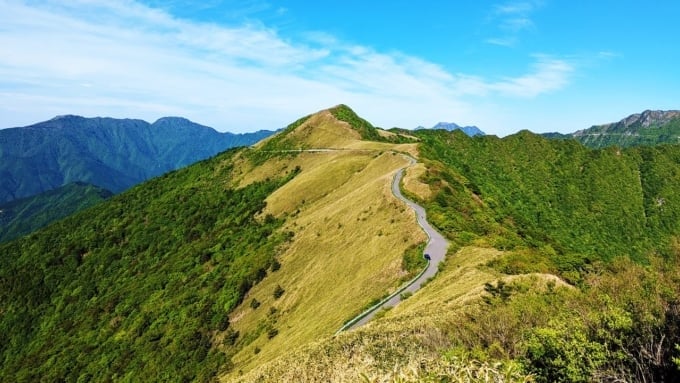
Kanpūzan was designated as a Sasagamine Natural Environment Conservation Area in 1982. It was once read as "Samukazeyama" using the same kanji, but is now called "Kanpūzan." The mountain belongs to the western part of the Shikoku Mountains, specifically the Ishizuchi Mountain Range.
From the summit, you can enjoy magnificent views of Sasagamine, other peaks of the Ishizuchi Mountain Range, and even the Seto Inland Sea and Pacific Ocean. Kanpūzan is renowned for being a beginner-friendly mountain, taking around 2 hours to climb from the base to the summit.
Name: Kanpūzan
Address: Saijō City, Ehime Prefecture
Official Website: http://powerspot.crap.jp/s/3845.html
20. A Branch Shrine of the Izumo Taisha Shrine in Shimane! "Izumo Taisha Matsuyama Branch"
Established in 1876 as a branch of the famous Izumo Taisha Shrine in Izumo City, Shimane Prefecture, the Matsuyama Branch Shrine is located west of Matsuyama Castle. Locally known as "Matsuyama's Izumo-san," it is revered for its blessings related to abundant harvests, prosperity, and is also famous as a "god of matchmaking" and "god of fortune."
From 2000 to 2013, the shrine underwent rebuilding due to the deterioration of its buildings.
Name: Izumo Taisha Matsuyama Branch Shrine
Address: 3-5-5 Honmachi, Matsuyama City, Ehime Prefecture
Official Website: http://powerspot.crap.jp/s/3254.html
21. In Spring, the Back of the Shrine Turns into a Cherry Blossom Mountain! "Kumano Shrine" in Saijō City
The enshrined deity is Kukunohime-no-Mikoto, and it was once known as "Oji Gongen" in ancient times. While the details of its origin remain unclear, the shrine holds an air of mystery. The shrine is located close to the Saijō Interchange, and to the east of it is Oji Pond with its construction memorial.
In spring, the mountain behind the shrine is covered in blooming cherry blossoms, making it a beloved spot for locals to enjoy hanami (cherry blossom viewing). The torii gate is beautifully surrounded by cherry blossoms, offering a stunning view.
Name: Kumano Shrine
Address: Takamatsu Forest, Tanbara Town, Saijō City, Ehime Prefecture
Official Website: http://powerspot.crap.jp/s/2171.html
22. Get Rid of Bad Luck and Pray for a Safe Year! "Yakuyoke Daishi, Henjouin Temple"
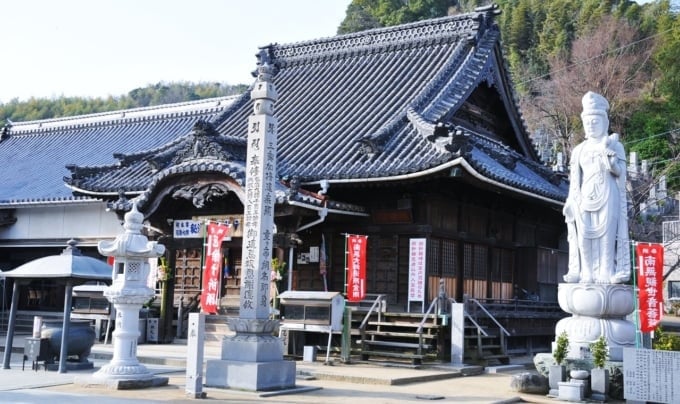
This temple is said to be the place where Kōbō Daishi, the founder of the Shingon sect, left behind a secret ritual to ward off bad luck when he was 42 years old. Every year on February 3rd, the Setsubun Grand Festival is held, and from March onwards, weekly prayers for warding off bad luck are conducted every Sunday at 12 PM.
January and February, around the Setsubun period, attract many visitors, and many come here to pray for protection from misfortune. To ensure a healthy, injury-free year, why not visit and offer your prayers? The Setsubun Grand Festival also features the offering of a mikoshi (portable shrine).
Name: Yakuyoke Daishi, Henjouin Temple
Address: 89 Kikuma Town, Imabari City, Ehime Prefecture
Official Website: http://www.ric.hi-ho.ne.jp/kikumahenjyouin/index.html
23. A Mysterious Spot that is the Sacred Object of the Shrine! "Tenchū-seki (Goto-seki)"
Located on Mount Ishizuchi in Saijō City, Ehime Prefecture, this massive stone stands at around 30 meters tall, taking the form of an oddly shaped stone pillar. Known as Goto-seki, it is the sacred object of Ken Shrine.
It is a hidden gem along the climbing route of Mount Ishizuchi and a power spot. The sight of this enormous stone standing majestically and mysteriously in the lush forest of Ishizuchi Mountain is truly captivating! When you climb Ishizuchi, don't miss this spot.
Name: Tenchū-seki (Goto-seki)
Address: Ishizuchi, Komatsu Town, Saijō City, Ehime Prefecture
Official Website: http://powerspot.crap.jp/s/5997.html
24. An Artistic Scenic Spot Created by Nature's Mysteries "Namerakawa Gorge Torii Iwa"
This beautiful single rock called "Namera" has been shaped into a gorge over many years due to the erosion caused by the flowing water along its riverbed. The riverbed itself is incredibly beautiful and can be considered a piece of art created by the power of nature. Just looking at it will give you a sense of peace and healing.
The Torii Iwa is said to be the guardian of the mountains surrounding Namerakawa Gorge, a fascinating spot where a large rock rests atop two split rocks.
Name: Namerakawa Gorge (Torii Iwa)
Address: 556 Myouka, Tōon City, Ehime Prefecture
Official Website: http://powerspot.crap.jp/s/4353.html
25. A Pilgrimage Site with 1300 Years of History! "Jōruri-ji Temple"

Jōruri-ji Temple was founded by the famous monk Gyōki in the early 8th century. Within the temple grounds stands a 1000-year-old tree called "Ibuki Byakushin," a natural monument of Matsuyama City, and Kōbō Daishi (Kōbō Daishi) is said to have revered and prayed under this tree.
Under this great tree, there is a stone said to be the Buddha’s footprints, bringing blessings of longevity and abundant harvests. To the left of the main hall, there is a small shrine dedicated to the goddess of music and arts, known as the Ichigan Bentendō, which is believed to bring spiritual favor for artistic talents.
Name: Jōruri-ji Temple
Address: 282 Jōruri Town, Matsuyama City, Ehime Prefecture
Official Website: http://www.88shikokuhenro.jp/ehime/46joruriji/
26. Autumn Brings a Power-Filled Festival! A Shrine with Dignity and Tradition "Iso-no-Jingu Shrine"
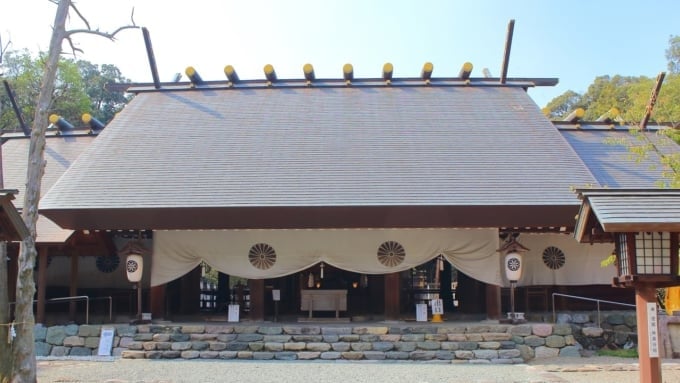
In 1982, the current Crown Prince, His Imperial Highness Prince Akihito, visited this shrine. The name "Iso-no" is sometimes written as "Isono."
This shrine has a history of nearly 2000 years, and its grand festival, held every October, is a must-see! Around 80 floats (danjiri) and portable shrines (mikoshi) are displayed, and the sight of these mikoshi gathered in the shrine's grounds is full of passion and excitement. A spot with both tradition and fervor.
Name: Iso-no-Jingu Shrine
Address: 1649 Nakano-Kō, Saijō City, Ehime Prefecture
Official Website: http://www.isonojinja.or.jp/
27. The Chief Deity Who Oversees All of Japan's Mountains! "Shingū Shrine" in Matsuyama
Ōyamatsumi no Mikoto is the deity responsible for overseeing and managing all of Japan's mountains. The god is also known as "Ōyamatsumi no Mikoto" or "Ōyama Zumi no Mikoto."
There are approximately 10,000 shrines dedicated to this deity across Japan, and one of them is Shingū Shrine. The shrine grounds feature three cedars that are estimated to be around 360 years old, which have been designated as a natural monument of Matsuyama City. A power spot where you can feel the immense energy of nature!
Name: Shingū Shrine
Address: 494 Fukumigawa Town, Matsuyama City, Ehime Prefecture
Official Website: http://powerspot.crap.jp/s/3982.html
28. Isang Lugar ng Paglalakbay na May 1300 Taong Kasaysayan! "Jōruri-ji Temple"
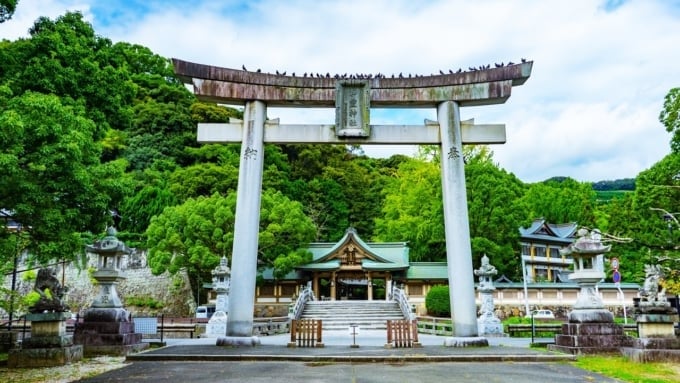
Itinatag ang Jōruri-ji Temple ni Gyōki, isang kilalang monghe, noong unang bahagi ng ika-8 siglo. Sa loob ng dambana, matatagpuan ang isang 1000-taong-gulang na puno na tinatawag na "Ibuki Byakushin," isang natural na monumento ng Lungsod ng Matsuyama, at sinasabing si Kōbō Daishi ay nagdasal at nirerespeto ang punong ito.
Sa ilalim ng malaking punong ito, matatagpuan ang isang bato na sinasabing mga yapak ng Buddha, na nagdadala ng mga biyaya ng mahabang buhay at masaganang ani. Sa kaliwa ng pangunahing hall, matatagpuan ang isang maliit na dambana na dedikado sa diyosa ng musika at sining, ang Ichigan Bentendō, na pinaniniwalaang nagdadala ng espiritwal na biyaya para sa mga talento sa sining.
Pangalan: Jōruri-ji Temple
Address: 282 Jōruri Town, Matsuyama City, Ehime Prefecture
Opisyal na Website: http://www.88shikokuhenro.jp/ehime/46joruriji/
29. Ang Taglagas Ay Nagdadala ng Isang Puno ng Enerhiya na Pista! Isang Dambana ng Tradisyon at Dignidad "Iso-no-Jingu Shrine"
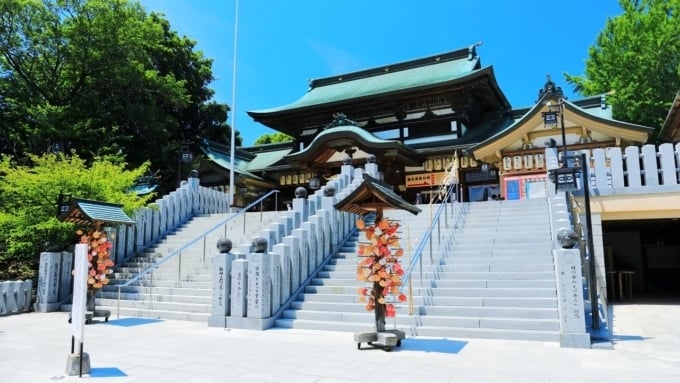
Noong 1982, ang kasalukuyang Crown Prince, His Imperial Highness Prince Akihito, ay bumisita sa dambanang ito. Ang pangalang "Iso-no" ay minsang isinusuong bilang "Isono."
Ang dambanang ito ay may kasaysayan ng halos 2000 taon, at ang kanilang malaking pista na ginaganap tuwing Oktubre ay isang hindi pwedeng palampasin! Humigit-kumulang 80 mga karwahe (danjiri) at portable shrines (mikoshi) ang ipinapakita, at ang tanawin ng mga mikoshi na nagtitipon sa bakuran ng dambana ay puno ng passion at excitement. Isang lugar ng tradisyon at kasigasigan.
Pangalan: Iso-no-Jingu Shrine
Address: 1649 Nakano-Kō, Saijō City, Ehime Prefecture
Opisyal na Website: http://www.isonojinja.or.jp/
30. Ang Pangunahing Diyos na Nangangasiwa ng Lahat ng Bundok ng Japan! "Shingū Shrine" sa Matsuyama
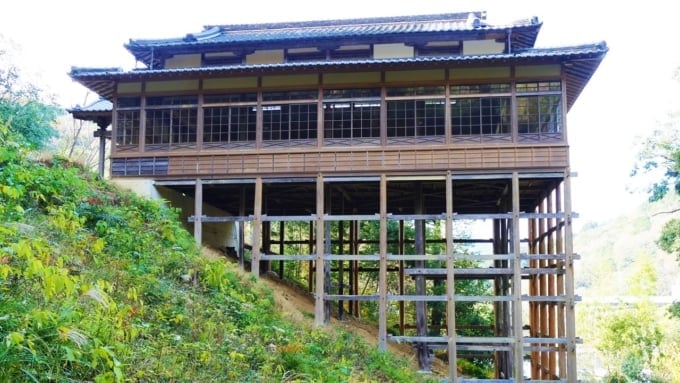
Si Ōyamatsumi no Mikoto ay ang diyos na responsable sa pagmamasid at pamamahala ng lahat ng bundok sa Japan. Ang diyos na ito ay kilala rin bilang "Ōyamatsumi no Mikoto" o "Ōyama Zumi no Mikoto."
Mayroong mga 10,000 dambana sa buong Japan na dedikado sa diyos na ito, at isa sa mga ito ay ang Shingū Shrine. Sa bakuran ng dambana matatagpuan ang tatlong cedar na tinatayang may 360 taon na, at itinataguyod bilang isang natural na monumento ng Lungsod ng Matsuyama. Isang power spot kung saan maaari mong maramdaman ang malaking enerhiya ng kalikasan!
Pangalan: Shingū Shrine
Address: 494 Fukumigawa Town, Matsuyama City, Ehime Prefecture
Opisyal na Website: http://powerspot.crap.jp/s/3982.html
31. A Must-See Historical Spot Representing Matsuyama, Ehime! "Matsuyama Castle"
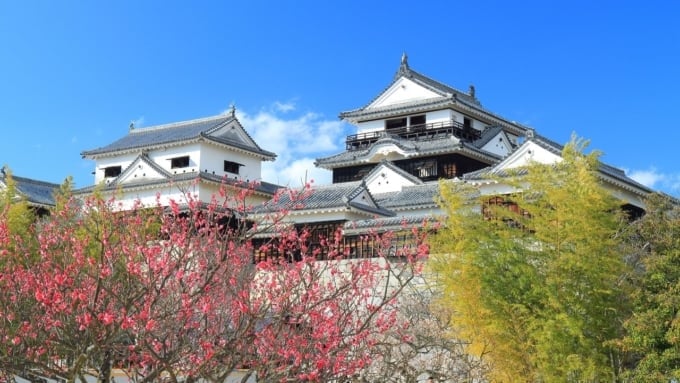
Also known as Kinki-jo (Golden Turtle Castle) or Katsuyama Castle, Matsuyama Castle is a flatland castle towering at 132 meters on Katsuyama in the center of Ehime Prefecture. The castle features a "connected style" structure, where the main tower, small towers, and yagura (turrets) form a square shape when viewed from the air. Along with Himeji Castle and Wakayama Castle, it is one of the "Three Major Connected Style Flatland Castles in Japan."
The atmosphere of the castle is filled with a strong feeling of warfare, so take your time to fully enjoy the romance of the Sengoku period.
Name: Matsuyama Castle
Address: Marunouchi, Matsuyama City, Ehime Prefecture
Official Website: http://www.matsuyamajo.jp/
32. A Temple with Many Power Spots for Pilgrims "Ishite-ji Temple"
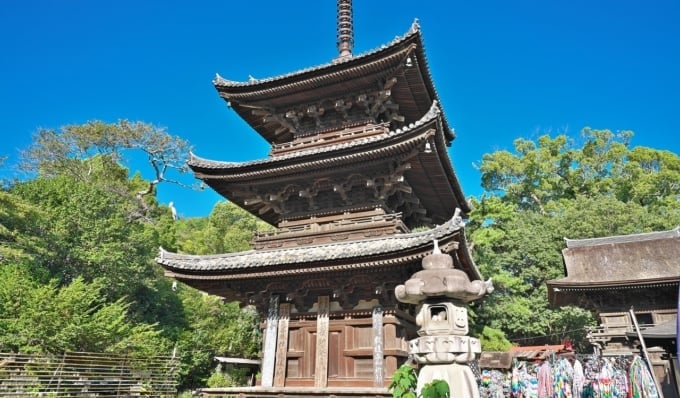
Ishite-ji Temple belongs to the Shingon sect's Toyoyama School and enshrines Yakushi Nyorai (the Medicine Buddha) as its principal deity. This temple is deeply connected to the legend of the warlord Kōno Emon Saburō, who is said to be the first person to have completed the pilgrimage. Ishite-ji is the 51st temple in the Shikoku 88 Temple Pilgrimage.
The temple is filled with numerous power spots, including the hanging ring, the childbearing stone, the wisdom wheel, and the mantra cave, all offering various blessings. It’s a wonderful temple worth visiting!
Name: Ishite-ji Temple
Address: 2-9-21 Ishite, Matsuyama City, Ehime Prefecture
Official Website: http://www.88shikokuhenro.jp/ehime/51ishiteji/
33. A Shrine Devoted to the God Who Governs the Mountains, Highly Revered by the Imperial Family "Ōyamatsumi Shrine"
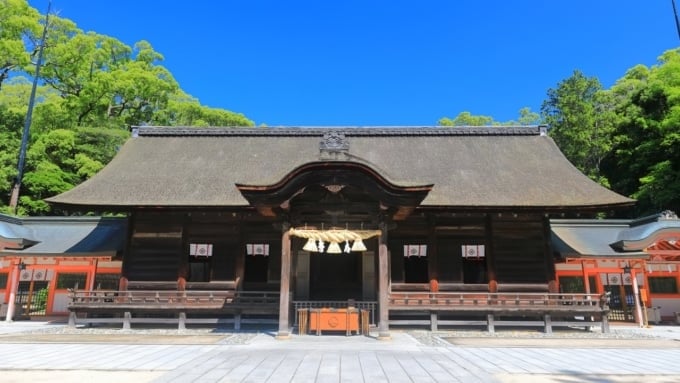
Like Shingū Shrine in Matsuyama, Ōyamatsumi Shrine enshrines Ōyamatsumi no Kami (the god who governs and protects all of Japan's mountains) and is considered the origin of other Yama-zumi shrines across the country.
The shrine houses 8 national treasures and 75 nationally designated important cultural properties, including the ancient camphor tree, said to be about 2600 years old, a national natural monument. The grandeur of the sacred gate made of hinoki wood fittingly honors the mountain god, giving the place a majestic and solemn atmosphere.
Name: Ōyamatsumi Shrine
Address: 3327 Miyura, Ōmishima Town, Imabari City, Ehime Prefecture
Official Website: https://goo.gl/vkPZ0U
◎ Summary
Ehime Prefecture is rich in legends, including those of the Heike clan's fugitives, Kōbō Daishi, and various gods enshrined in temples related to Japan’s ancient tales. Not only is the region steeped in history, but it is also full of places related to gods and legends.
However, power spots have different energies depending on their locations, so it is recommended to visit places that match your own energy. To find the best power spots for you, it's important to know your Kenki Zokusei (a special attribute related to the five elements—Earth, Water, Fire, Air, and Sky)—which can be determined based on your birthdate and a specific calculation method.
Be sure to explore the power spots in Ehime that can boost your unique fortune!
RELATED ARTICLES
REGIONS
CATEGORIES
FEATURED ON Guide
-
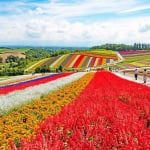
Where will you go for the summer vacation? Introducing recommended spots for domestic travel
-
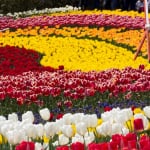
Kaizu City’s Recommended 7 Tourist Spots. Enjoy the Culture and History Nurtured by Wajū!
-
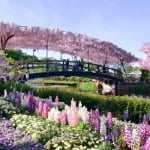
What Makes Ashikaga Flower Park So Special? A Treasure Trove of Photo-Worthy Spots!
-
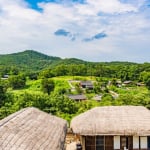
600 Years of Radiant Tradition: Korea’s Historic Villages of Hahoe and Yangdong
-

Two-Colored Seas and a Pink Beach! 4 Must-Visit Spots in North Eleuthera
MOST POPULAR ON Guide
-
 1
1Doha: Must-see Attractions in the Capital of Qatar
-
 2
2Toronto: 10 Things to do in this Picturesque Canadian City
-
 3
3Amarillo: A City Famous for It’s Amazing Canyons, Great History and Music
-
 4
4South Korea: Dazzling Scenery, Rich Culture and Fascinating History
-
 5
5Kuwait: A Country in Middle East Asia Famous for Hot Sand Dunes and Stunning Cityscape



